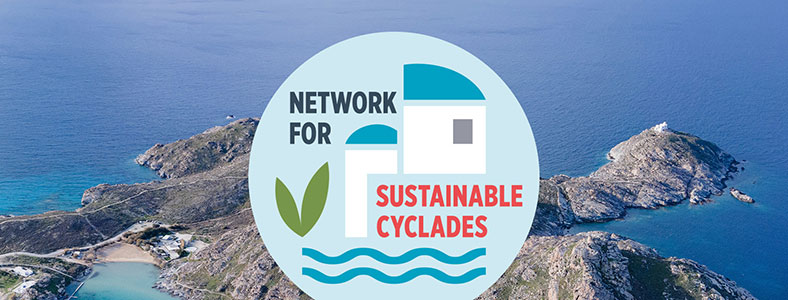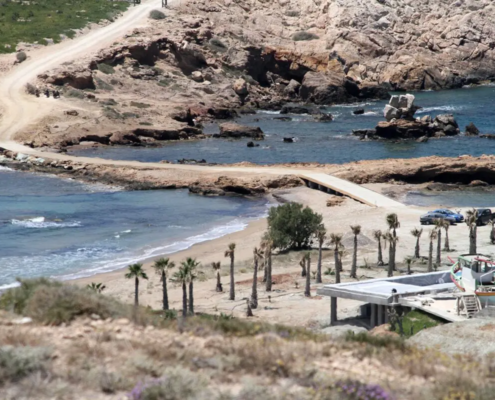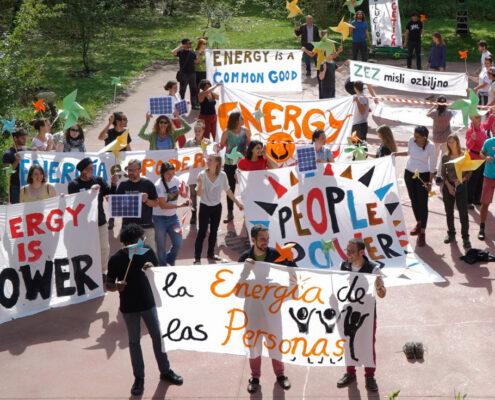Network for Sustainable Cyclades
Founding Declaration
Sifnos 28/10/2023 (1)
We, the signatories, were in Sifnos, coming from different islands of the Cyclades, on the occasion of our participation in the Workshop on the theme: “The fragile, handmade landscape of Sifnos, now in danger!” where we found that we have common views and common anxieties for the future of the unique Cyclades. Considering that we express many more than the present, we decided to join forces for a different, sustainable future for our islands.
1- The problem:
The natural and built landscape of the Cyclades, more than a thousand years old, handmade, unique and fragile, is in imminent danger of permanent and irreversible disappearance of its basic structural characteristics, despite the obligations arising from European legislation, the Treaty of Florence on Landscape and its incorporation into the existing Greek institutional framework.
The Cycladic Islands have been a dream and a haven of peace and authenticity for millions of people worldwide since the 1950s. However, they are currently threatened by the senseless overexploitation of their unique gifts and the image they have created worldwide through constructions of a different scale and aesthetics.
The last decade’s uncontrolled tourist development and incompatible building practices have resulted in aggressive land claims by powerful interests seeking real estate and strategic investments in the Cyclades. As a result, there has been a significant increase in agricultural land abandonment. The island’s lack of water resources, waste management issues, traffic and noise, alteration of the landscape, and degradation of public spaces by single-use plastics, cars, sunbeds, and umbrellas have further compounded the problem, leading to the degradation of marine life.
How many people can an island ultimately accommodate, not only without being altered but “withstanding” the daily pressures of each element of its unique capital, even if its management is dramatically improved? Has the carrying capacity already been exceeded, at least on some islands?
The continuing anxiety of residents, workers, and businessmen to ensure sufficient income during the short tourist season has resulted in a new expression, “it’s only two months and it will pass,” which reveals the annoyance of many with the current situation of frantic 24-hour rhythms, where the working conditions of all are the first victim. Those who have chosen the islands as their second home are also showing discontent, while more than a few are leaving them. Overtourism has arrived.
While acknowledging the economic benefits of tourism, it appears that this industry has reached its limits. The natural, cultural, social and productive elements that allow for its sustainability are deteriorating. Its replacement by another form of artificial capital – however much the younger settlers of the islands may have no image of the past to compare with – can hardly have similar results. Therefore, we need to focus on planning and managing the natural and built environment, protecting and strengthening the primary sector and local economy, and promoting the cohesion of local communities. We must also address the challenges of the climate crisis and strive for the sustainability and self-sufficiency of the islands. In this context, tourism development should be just one of the factors considered in a comprehensive plan to protect and develop islands.
2- Our options:
In front of us, there are three paths that lead to different outcomes:
- Path one is business as usual, where we continue to grow by focusing on relaxation and leisure tourism without any spatial or other limitations, with little change from the status quo. However, this path will require new large-scale infrastructure to cope with the overload of existing ones (such as desalination, ports, roads, airports, sewage systems, etc.). Unfortunately, this approach has corresponding consequences, including the inability to comply with the law at all levels. We already see this happening with the occupation of public spaces, illegal buildings, the illegal operation of shops, the destruction of flora and fauna in the sea and on land, etc.
- Path two is the continued growth of tourism with relative diversification of the dominant product,based on spatial restrictions in real estate (large facilities and scattered building), significant management interventions in traffic, restrictions in resource consumption and waste generation based on the carrying capacity of the islands, and avoidance of over-tourism.
- Path three is a change of the existing development model in favour of another one aiming at sustainability. This new model should not only include an economy that continues to produce but also a more just and cohesive society and a healthy environment. As far as tourism goes, it will always be an important part of the local economy, but not the only one. Therefore, a model should be chosen that takes into account the scale of the islands, the available resources, and the specificity of local communities.This model should offer well-being and wellness for visitors and residents through the promotion of local resources (experiential tourism).
3- Our Proposal:
As individuals who understand the pressing need to save the Cycladic landscape and promote the sustainability of our islands, we believe that our efforts should focus on informing, raising awareness, and mobilizing local communities towards the third option: the overthrow of the existing model and the demand for a new one.. To accomplish this, we need to shift our priorities from the current practices that have led us to the current situation and adopt principles prioritising sustainable and attractive islands.
Α. For a balanced model of economic and social life aiming at sustainability.
The transformation of the existing development model requires the development of activities that:
- Focus on soft tourism, which works in harmony with the primary and secondary sectors, and other service activities, to promote a flourishing environment,
- Protect and enhance the Cycladic physiognomy, which includes the culture, history, architecture, arts, traditions, tastes, aromas, and environment
- Utilize craftsmen, connoisseurs, and scientists to perform site-specific interventions
- Disperse visitors over longer periods of the year, reducing the suffocation in summer and the desolation in other months
- Contribute to climate neutrality
We aim to steer the Cyclades towards an economic model that embraces tourism, but not at the expense of other industries. Instead, we want to prioritize sustainable, small-scale tourism that highlights the unique characteristics of each island. By combining tradition, skills, and new knowledge, we can create high-quality products and services that set us apart from other destinations. This approach will allow entrepreneurs and workers to earn a satisfactory income while maintaining good working and living conditions, ultimately leading to a better quality of life.
Β. For a balanced coexistence of modern island societies with their unique place.
The preservation of the elements of the Cycladic physiognomy requires a change in the management of space and natural resources, especially under the worsening climate crisis.
We need spatial planning based on the recognition of the specificity of the vulnerable biodiversity and morphology of the Cycladic landscape, along with the special conditions imposed by the insularity and the already existing situation on the islands, and will offer competitive solutions for economic, social and cultural development of the islands that will not destroy but preserve the island landscape.
With special emphasis to:
- the protection of agricultural land and agricultural production as well as the dry stone terraces (as a monument included in the UNESCO World Heritage List and as a green infrastructure) and the protection of NATURA areas by avoiding any building within their boundaries
- the protection of all man-made elements of the Cycladic landscape (walking paths, traditional settlements, technical works, traditional farm houses, fountains, agricultural structures, etc.)
- sustainable maritime spatial planning, protection and restoration of the coastal zone and marine biodiversity, protection/restoration of wetlands
- the protection of the island landscape from the effects of the climate crisis (erosion, drought, flood risks, heat waves, etc.)
- the planning and management of energy resources with the aim of climate neutrality, but with care for the protection of the landscape (combined forms of renewable energy, geothermal energy).
But also by policies (state and local), which will support:
- local primary and secondary production, preserving, exploiting and highlighting local varieties and the conditions for their continued cultivation,
- efficient waste and wastewater management with the ultimate goal of zero waste,
- strengthening the self-sufficiency of the islands with maximum support for connectivity and cooperation between them. (A crucial role in this is played by the intra-cycladic ferry interconnection, along with a number of other interventions that can support the exchange of products between the islands),
- protecting water resources and safeguarding the use and distribution of water according to the needs of sustainability, under the control and in the interests of local communities alone,
- the re-education of all of us, residents and visitors, children, young people and adults, with an emphasis on the education of the youngest, in a new living relationship with the precious landscape in which we are lucky enough to live and come into contact, as well as the historical conditions that led to its formation.
4- Our Action:
We need to act and react immediately. The destructiveness of this predatory development has already had a severe impact on our islands and the rate of its spread is rapid. Our collective demand must be equally dynamic.
We need the active participation of all: citizens and institutions, local and national, even European and global, that understand the special importance of our islands.
We need formal and informal networks to co-construct and support the hope for safe, sustainable and prosperous Cycladic islands and to ensure active support for our vision and action, especially from the central political subject of any change, which is the islanders themselves.
We invite all those who agree with our objectives to join forces to collectively support whatever specific initiatives each of the participants can undertake in any of the endless fields that make up our proposal.
We are launching the creation of the Network for Sustainable Cyclades.
Signed by those who participated in the meeting of 28 October 2023 in Sifnos, as well as by those (individuals and associations) who joined by submitting the form below. The list of members who have consented to the publication of their names can be found on the“About Us” page.
(1) The text was written by the editorial team appointed at the meeting on October 28th in Sifnos, consisting of Tonia Panteliou, Yannis Spilanis, Nikos Chrysogelos, Eleni Tzirtzilaki, Monica Themou, Alkmini Paka.
Follow us
follow our Facebook page
Join the group!
join our Facebook group!
Follow us
follow us on Instagram



Share this page